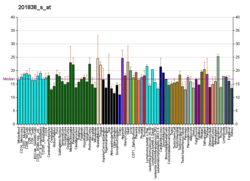| SUPT7L |
|---|
|
| Identifiers |
|---|
| Aliases | SUPT7L, SPT7L, STAF65, STAF65(gamma), STAF65G, SUPT7H, SPT7-like STAGA complex gamma subunit, SPT7 like, STAGA complex gamma subunit, SPT7 like, STAGA complex subunit gamma |
|---|
| External IDs | OMIM: 612762; MGI: 1919445; HomoloGene: 8907; GeneCards: SUPT7L; OMA:SUPT7L - orthologs |
|---|
| Gene location (Human) |
|---|
 | | Chr. | Chromosome 2 (human)[1] |
|---|
| | Band | 2p23.3 | Start | 27,650,809 bp[1] |
|---|
| End | 27,663,840 bp[1] |
|---|
|
| Gene location (Mouse) |
|---|
 | | Chr. | Chromosome 5 (mouse)[2] |
|---|
| | Band | 5|5 B1 | Start | 31,671,908 bp[2] |
|---|
| End | 31,685,151 bp[2] |
|---|
|
| RNA expression pattern |
|---|
| Bgee | | Human | Mouse (ortholog) |
|---|
| Top expressed in | - middle temporal gyrus
- right uterine tube
- anterior pituitary
- right hemisphere of cerebellum
- left ovary
- apex of heart
- right ovary
- granulocyte
- right lobe of thyroid gland
- right frontal lobe
|
| | Top expressed in | - Rostral migratory stream
- zygote
- secondary oocyte
- tail of embryo
- ventricular zone
- genital tubercle
- aortic valve
- cumulus cell
- ascending aorta
- proximal tubule
|
| | More reference expression data |
|
|---|
| BioGPS | 

 | | More reference expression data |
|
|---|
|
| Gene ontology |
|---|
| Molecular function | - transcription coactivator activity
- protein binding
- histone acetyltransferase activity
- protein heterodimerization activity
| | Cellular component | | | Biological process | - regulation of transcription, DNA-templated
- maintenance of protein location in nucleus
- histone H3 acetylation
- transcription, DNA-templated
- positive regulation of nucleic acid-templated transcription
| | Sources:Amigo / QuickGO |
|
| Orthologs |
|---|
| Species | Human | Mouse |
|---|
| Entrez | | |
|---|
| Ensembl | | |
|---|
| UniProt | | |
|---|
| RefSeq (mRNA) | |
|---|
NM_001282729
NM_001282730
NM_001282731
NM_001282732
NM_014860 |
| |
|---|
| RefSeq (protein) | |
|---|
NP_001269658
NP_001269659
NP_001269660
NP_001269661
NP_055675 |
| |
|---|
| Location (UCSC) | Chr 2: 27.65 – 27.66 Mb | Chr 5: 31.67 – 31.69 Mb |
|---|
| PubMed search | [3] | [4] |
|---|
|
| Wikidata |
| View/Edit Human | View/Edit Mouse |
|



















